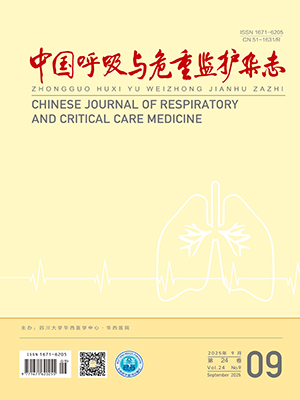| 1. |
Modi AR, Kovacs CS. Hospital-acquired and ventilator-associated pneumonia: diagnosis, management, and prevention. Cleve Clin J Med, 2020, 87(10): 633-639.
|
| 2. |
Suaya JA, Fletcher MA, Georgalis L, et al. Identification of Streptococcus pneumoniae in hospital-acquired pneumonia in adults. J Hosp Infect, 2021, 108: 146-157.
|
| 3. |
Rosenthal VD, Maki DG, Mehta Y, et al. International Nosocomial Infection Control Consortium. International Nosocomial Infection Control Consortium (INICC) report, data summary of 43 countries for 2007-2012. Device-associated module. Am J Infect Control, 2014, 42(9): 942-956.
|
| 4. |
American Thoracic Society; Infectious Diseases Society of America. Guidelines for the Management of Adults with Hospital-acquired, Ventilator-associated, and Healthcare-associated Pneumonia. Am J Respir Crit Care Med, 2005, 171(4): 388-416.
|
| 5. |
Magill SS, Edwards JR, Bamberg W, et al. Multistate point-prevalence survey of health care-associated infections. N Engl J Med, 2014, 370(13): 1198-1208.
|
| 6. |
Koulenti D, Lisboa T, Brun-Buisson C, et al. Spectrum of practice in the diagnosis of nosocomial pneumonia in patients requiring mechanical ventilation in European intensive care units. Crit Care Med, 2009, 37(8): 2360-2368.
|
| 7. |
Giuliano KK, Baker D, Quinn B. The epidemiology of nonventilator hospital-acquired pneumonia in the United States. Am J Infect Control, 2018, 46(3): 322-327.
|
| 8. |
Yang M, Yan YP, Yin XL, et al. Chest physiotherapy for pneumonia in adults. Cochrane Database Syst Rev, 2010, (2): CD006338.
|
| 9. |
McAlinden B, Kuys S, Schibler A, et al. Chest physiotherapy improves regional lung volume in ventilated children. Crit Care, 2020, 24(1): 440.
|
| 10. |
Shi Y, Yang ZG, Xie F, et al. The research progress of electrical impedance tomography for lung monitoring. Front Bioeng Biotechnol, 2021, 9: 726652.
|
| 11. |
Nishimura M. Electrical Impedance Tomography: The Promise of Noninvasive Lung Images at the Bedside. Respir Care, 2020, 65(3): 402-403.
|
| 12. |
中华医学会呼吸病学分会感染学组. 中国成人医院获得性肺炎与呼吸机相关性肺炎诊断和治疗指南(2018年版). 中华结核和呼吸杂志, 2018, 41(4): 255-280.
|
| 13. |
何礼贤. 重症医院获得性肺炎的诊治与控制. 中华内科杂志, 2001, 40(3): 145-147.
|
| 14. |
Belli S, Prince I, Savio G, et al. Airway clearance techniques: the right choice for the right patient. Front Med (Lausanne), 2021, 8: 544826.
|
| 15. |
He HW, Chi Y, Long Y, et al. Three broad classifications of acute respiratory failure etiologies based on regional ventilation and perfusion by electrical impedance tomography: a hypothesis-generating study. Ann Intensive Care, 2021, 11(1): 134.
|
| 16. |
Torres A, Niederman MS, Chastre J, et al. International ERS/ESICM/ESCMID/ALAT Guidelines for the Management of Hospital-acquired Pneumonia and Ventilator-associated Pneumonia: Guidelines for the Management of Hospital-acquired pneumonia (HAP)/Ventilator-associated Pneumonia (VAP) of the European Respiratory Society (ERS), European Society of Intensive Care Medicine (ESICM), European Society of Clinical Microbiology and Infectious Diseases (ESCMID) and Asociación Latinoamericana del Tórax (ALAT). Eur Respir J, 2017, 50(3): 1700582.
|
| 17. |
Frownfelter D, Dean E. Cardiovascular and Pulmonary Physical Therapy: Evidence to Practice, 5th edn. St. Louis: Elsevier, 2012, 309-339.
|
| 18. |
Alison J, Barrack C, Cafarella P, et al. The Australian Lung Foundation pulmonary rehabilitation toolkit[EB/OL]. (2009). Retrieved from: http://www.pulmonaryrehab.com.au/welcome.asp.
|
| 19. |
Jiang HY, Li Q, Yu X, et al. Ventilation improvement after pneumonia treatment evaluated with electrical impedance tomography: an observational study. Physiol Meas, 2021, 42(10): abffbf.
|
| 20. |
Fahy JV, Dickey BF. Airway mucus function and dysfunction. N Engl J Med, 2010, 363(23): 2233-2347.
|
| 21. |
Longhini F, Bruni A, Garofalo E, et al. Chest physiotherapy improves lung aeration in hypersecretive critically ill patients: a pilot randomized physiological study. Crit Care, 2020, 24(1): 479.
|
| 22. |
Freitas DA, Chaves GS, Santino TA, et al. Standard (head-down tilt) versus modified (without head-down tilt) postural drainage in infants and young children with cystic fibrosis. Cochrane Database Syst Rev, 2018, 3(3): CD010297.
|
| 23. |
Üzmezoğlu B, Altıay G, Özdemir L, et al. The efficacy of Flutter® and active cycle of breathing techniques in patients with bronchiectasis: a prospective, randomized, comparative study. Turk Thorac J, 2018, 19(3): 103-109.
|
| 24. |
Muscedere JG, Day A, Heyland DK. Mortality, attributable mortality, and clinical events as end points for clinical trials of ventilator-associated pneumonia and hospital-acquired pneumonia. Clin Infect Dis, 2010, 51(Suppl 1): S120-S125.
|
| 25. |
Kollef MH, Hamilton CW, Ernst FR. Economic impact of ventilator-associated pneumonia in a large matched cohort. Infect Control Hosp Epidemiol, 2012, 33(3): 250-256.
|
| 26. |
刘又宁, 曹彬, 王辉, 等. 中国九城市成人医院获得性肺炎微生物学与临床特点调查. 中华结核和呼吸杂志, 2012, 35(10): 739-746.
|
| 27. |
Janssens W, Corhay JL, Bogaerts P, et al. How resources determine pulmonary rehabilitation programs: a survey among Belgian chest physicians. Chron Respir Dis, 2019, 16: 1479972318767732.
|
| 28. |
丛舒, 王宁, 樊静, 等. 2014-2015年中国40岁及以上慢性阻塞性肺疾病患者呼吸康复治疗情况. 中华流行病学杂志, 2020, 41(7): 1014-1020.
|
| 29. |
Troosters T, Blondeel A, Janssens W, et al. The past, present and future of pulmonary rehabilitation. Respirology, 2019, 24(9): 830-837.
|




